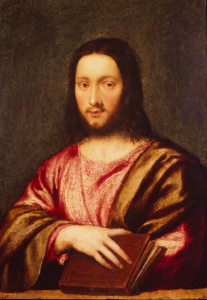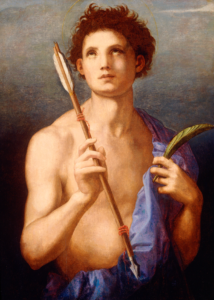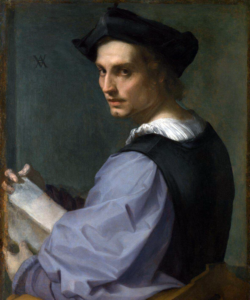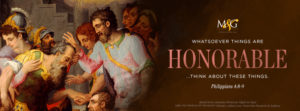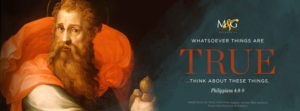Christ the Redeemer
Oil on panel, c. 1545
Paris Bordone
Venetian, 1500-1571
Museums are filled with works of art of all shapes and sizes. Of course, the large paintings immediately grab a viewer’s attention. However, it is sometimes the small pieces that bring viewers in close and create intimate connections. One of these examples from the Museum & Gallery is a work called Christ the Redeemer. It is a half-length portrait of Christ holding a book, and with its frame it is only around 18 inches by 15 inches. Despite its somewhat simple subject matter and small stature, this painting draws you in and raises questions.
One question woven into the work is the identification of the artist. Various art historians confirm its sixteenth-century Venetian origins because of its color palette and brushwork. When the painting originally became part of the Museum collection in 1954, the artist attached to it was the Venetian Renaissance master Titian. Regarded by his contemporaries as “The Sun Amidst Small Stars,” Titian had a successful career throughout his life and his studio became one of the most influential of the Italian Renaissance. There are specific similarities between Titian’s other portraits of Christ and this Christ the Redeemer such as facial features, the treatment of the hands, as well as previous miniatures created by Titian—which seem to confirm the master’s authorship. However, more recent art historians claim that while the panel is certainly Titianesque, the more likely artist is another Venetian painter, Paris Bordone. Bordone studied under Titian and emulated the master’s style so well that many of Bordone’s works have been misattributed to Titian’s hand. He may not have had as glittering a career as Titian, but Bordone was a successful painter, earning respect and fame during his lifetime.
Another question is the iconography of the painting. The portrait of Christ with a book is not an uncommon one. It reflects the words from John 1:1, “In the beginning was the Word, and the Word was with God, and the Word was God.” Since Early Christian art, Christ has been shown either enthroned in majesty or surrounded by various saints holding a book, which is more than likely the Gospels. What becomes interesting is this iconography continues in Eastern Orthodox art, but becomes rare in post-Medieval Western art. One reason Bordone may have included this iconography is because it was similar to another kind of portrait—a scholar. Portraits of scholarly gentlemen or philosophers were common across Italy. M&G includes an example of these portraits with Giambattista Tiepolo’s A Philosopher Holding a Book. Using a familiar portrait pose, viewers could relate to Christ in the context of the ultimate Rabbi and teacher.
Another reason Bordone may have chosen this pose and iconography is because of its size and purpose. Less than two feet on each side, this painting is a perfect example of a cabinet painting. From the fifteenth century on, wealthy patrons would purchase these small, detailed paintings to hang in small, intimate spaces in their vast homes. These spaces, called cabinets, functioned as small offices or sitting rooms. Because of its size, the cabinet painting draws the viewer in and creates an intimate connection. Knowing this, it is understandable why Bordone may have created Christ in such a pose. It allows the viewer an opportunity to sit one-on-one with the Master Rabbi.
No matter the reasoning of the iconography or even which artist created the work, Christ the Redeemer is an intriguing painting. Like its original purpose, the small panel captivates the viewer. Maybe it will also cause the viewer to ask questions. Maybe it will draw the viewer closer to Christ as the ultimate teacher and incarnate Word in flesh.
KC Christmas Beach, M&G summer educator
Published 2024
